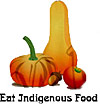



Page Navigation Buttons--- |
|---|
 Decolonize Now items on CafePress Visit our Amazon.com Native foods shop |
What we eat -- where it comes from, how it is raised, processed, cooked -- affects our health in many ways. Traditional native diets in those few places in the world where people still mostly eat what they raise, hunt, gather, fish -- have been found to promote health and long life, for reasons only gradually coming to be understood. It isn't practical to recommend now for most of us that we eat buffalo, harvest wild rice, farm corn in single hills, gather waupatoo or teepsinna. We'll see why those traditional foods are health-promoting as modern biological and medical sciences have belatedly learned. We'll see practical ways to improve health by food and diet -- starting when you are young to eat well to avoid health problems later. Cultural food stories and practical recipes are here too. InfoSeek Select Site -- for this Traditional Foods section. It's always nice to be appreciated. I really put in a lot of work on this section -- the recipes take quite a while to type and index-link.
Native spokes-people, organizations testify how funding cuts are going to literally create Native hunger and health problems. Oneida Nation spokesperson Ray Halbritter testifies clearly and concisely how Gaming Act changes will stop those tribes who do have successful casinos from filling in gaps with the only Native enterprise that has actually proven successful. The National Indian Education Association states how "food for the minds" of our Native youth will be reduced to starvation diet too. But kids who are litrerally physically hungry are not able to pay attention to their studies much anyway. That's why we try to have substantial hot lunch and if possible hot breakfast programs in our schools. To provide nutrition they otherwise don't get.
|
|---|
|
|
Two Moons (Months) of Sacred Food: Maple Sugar and Wild Rice
Oneida Nation Native Foods Yum, nice looking pages, some fine recipes.
RECOMMENDED BOOKS -- for heavy-duty researchers and for students.
|
|---|

Custom Search
|
 TOP of Page TOP of Page |
 Recipes, quite a lot, indexed. Cookbooks Recipes, quite a lot, indexed. Cookbooks |
 Native Herbal Knowledge Native Herbal Knowledge |
 --MAIN MENU |
|---|
Webmistress -- Paula Giese.Text and graphics copyright 1995.
CREDITS: The bear-spirit page logo was a black-and-white ink drawing given to Akwesasne Notes in 1974; it is a a drawing by Canadian Anishinaabe Norval Morrisseau. It depicts the Great Bear spirit bringing life and health to a person, and also the sky constellation Big Dipper (with artist's license to rearrange the stars somewhat). I scanned and colored it in 1993 from its only appearance in Notes. I drew the moon logo. The original was destroyed around 1978 by an arson-set fire to the Notes building.
Last Updated: 6/7/97